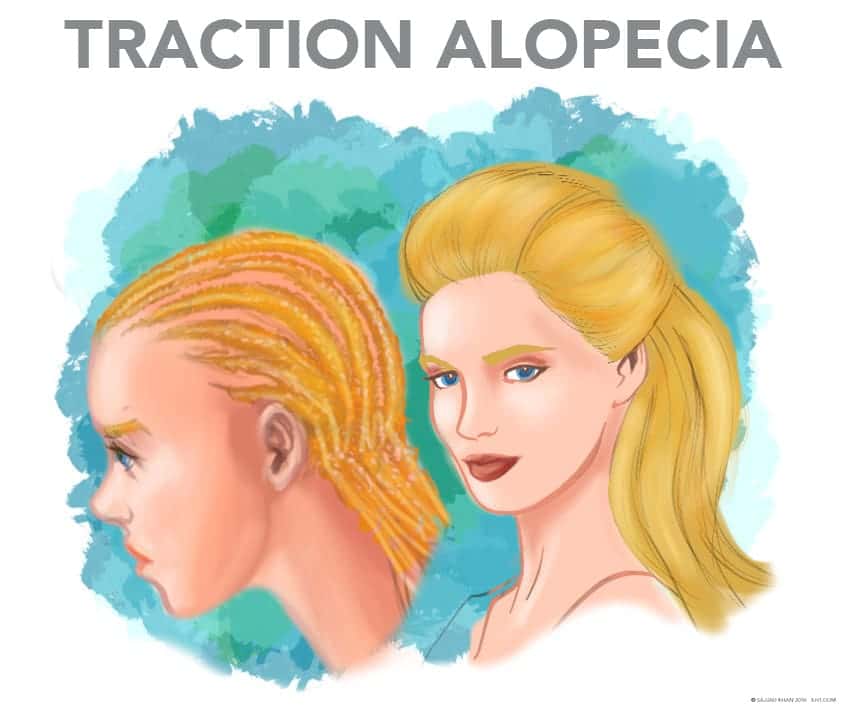Women Hair Loss Treatments For Temporary Hair Loss
Temporary Hair loss ( Less than 12 month duration )
Hair Loss Treatments For Nutritional Deficiencies
The doctor should regard this possibility as the most likely and should look carefully for nutritional deficiencies. Micronutrient diagnostic tests detect the deficiencies in following essential hair nutrients, Water, Protein, Iron, Vitamin-A, C, D, E, Zinc, Silica, Selenium, Copper, Magnesium, Potassium, Calcium, Omega-3 fatty acids, and B-complex vitamins, especially Biotin, Niacin, and Cobalamin. Once the deficient nutrients are added in the diet the temporary lost hair grows back.
Iron Deficiency Anemia Treatment
The body’s iron stores are replenished by eating food rich in iron and by using medicine as well.
The foods that will help to increase the body’s intake of iron:
- Meat
- Poultry
- Fish
- Leafy greens
- Legumes
- Whole grains
Most people with an iron deficiency need 150-200 mg per day of elementary iron (2 to 5 mg of iron per kilogram or 1 to 1.5 mg per pound of body weight). Vitamin-C (ascorbic acid) improves iron absorption and some doctors recommend that individuals suffering from this deficiency take 250 mg of vitamin-C along with the iron.
Treatment Of Hair Loss Due To Weight Loss
The lost hair due to weight loss Grows back following stopping the further weight loss and resuming a good nutrition and exercise plan. The temporary lost hair usually grows back without any medical intervention.
Treatment Of Traction Hair Loss
Try not pull your hair too tightly back and try not to use the extensions regularly. Once the traction stress is taken away, hair usually grows back.
Treatment Of Hair Loss Due To Prescription Medicines
One should discuss with his doctor whether other medicines for the same condition can be substituted. Most of the time once the medicines are substituted, hair loss stops.
As in chemotherapy, there are not many choices, A cold pack applied to the scalp during chemotherapy usually protects most of the scalp hair from the loss.
Contraceptives Hair Loss Treatment
If hair loss happens in response to hormonal contraceptives, ask your doctor about using low-androgen-index-birth-control-contraceptives. If hair loss persists, even with low-androgen-index contraceptives, then use non-hormonal means of birth control.
Treatment Of Hair Loss Due To Hypothyroidism
The standard treatment for hypothyroidism involves the daily use of the synthetic thyroid hormone, levothyroxine: the patient is started on 50 micrograms, which can be increased, according to need, to 100. This oral medication restores adequate hormone levels, reversing the signs and symptoms of hypothyroidism and mostly reverses the hair loss.
Treatment Of Hair Loss Due To Hyperthyroidism
Anti-thyroid medications and radioactive iodine are also used to slow the production of thyroid hormones. Sometimes, treatment of hyperthyroidism involves surgery, to remove all or part of the thyroid gland. Restoring the normal hormones level mostly reverses the hair loss.
Treatment For Stress Related Hair Loss
The following methods are effective in reducing the stress and stress related hair loss
- Exercise To Reduce The Stress Hormone Cortisol
- Meditation Can Help Desensitize Stressful Triggers
- Relax On Weekends
- Create Predictability At Work And At Home
- Eat Healthy, Complex Carbs, Oats, And Whole Grains To Increase Serotonin, A Calming Brain Chemical
- Eat Green, Leafy Vegetables: They Provide Magnesium, Reducing The Effects Of Stress
- Citrus Fruit, Its Vitamin-C, Will Increase Immunity And Reduce Stress Hormones
- Nuts, Especially Almonds And Pistachios, Provide Vitamins-E And B And Healthy Fat And Help Protect You Against The Effects Of Stress
- Fatty Fish Provides Omega-3, Which Prevents A Surge In Stress Hormones
- Avocado And Bananas Provide Potassium And Help Reduce The Increased Blood Pressure, Which Is A Consequence Of Stress
- A Complex Carb Snack At Bedtime Increases The Brain-Calming Chemical Serotonin And Leads To Better Sleep
- Black Tea Blocks The Formation Of Stress Hormones After A Stressful Event
- Eating Raw Vegetables Helps Release A Clenched Jaw Caused By Stress
Treatment For Pregnancy Related Hair Loss
The hair loss usually peaks 3-4 months after delivery. this hair loss is temporary, and hair loss returns to normal within six to twelve months. Only nutritional deficiencies during pregnancy can affect your hair adversely, supplement your diet from food sources rich in B-complex vitamins, vitamin C, vitamin E, and Zinc.
Treatment Of Hair Loss Due To Polycystic Ovarian Syndrome
First of all, it’s important to regulate the menstrual cycle, a doctor may recommend combination birth-control pills—pills that contain both estrogen and progestin. These birth-control pills decrease androgen production, give the patient’s body a break from the effects of continuous increased androgen and increased estrogen which comes from androgen conversion into estrogen, it lowers the risk of endometrial cancer and limits abnormal bleeding and reverses hair loss.
To slow the growth of excessive body hair, reverse the hair loss a doctor may recommend birth-control pills to decrease androgen production—or another medication, Spironolactone (Aldactone), which blocks the effects of androgens on the skin and reduces excess facial and body hair (hirsutism), adult acne, and female-pattern hair loss (androgenic alopecia). Because Spironolactone can cause birth defects, effective contraception is required when a person is using the drug, and it is not recommended if that person is pregnant or planning to become pregnant. Eflornithine(Vaniqa) is another medication possibility: the cream slows facial hair growth in Women.
Treatments Of Hair Loss Due To Extreme Sickness Or Major Surgery
Once the person recovers from extreme sickness or major surgery and resumes good nutrition and exercise plan, the lost hair usually grows back.
Treatment For Hair Loss Associated With Menopause
Estrogen therapy remains, by far, the most effective treatment option for relieving menopausal symptoms. Bringing the estrogen-androgen balance to pre-pause levels relieves menopausal symptoms, decreases the risk factors for heart disease, and reduces hair loss.
Female Hair Loss Treatments For Long Lasting Androgenetic Female Pattern Hair Loss
We can divide female hair loss treatments into two major types
- Medical Treatments
- Surgical Treatments
Medical Treatments
There are three classes of medical treatments.
- Minoxidil
- Regenerative treatments – ECM, PRP and LLLT
- Medicines affecting the male hormone pathway.
Minoxidil
It was approved for use as an Antihypertensive medicine, one of its side effect was hair growth. Minoxidil is a potassium channel opener and a vasodilator and is FDA approved for hair loss and is more effective in women.
- Minoxidil mechanism of action for increase in hair growth is unknown.
- Minoxidil 5% solution or foam applied to the scalp twice a day, resulted with 45% of the women experiencing increase in hair regrowth.
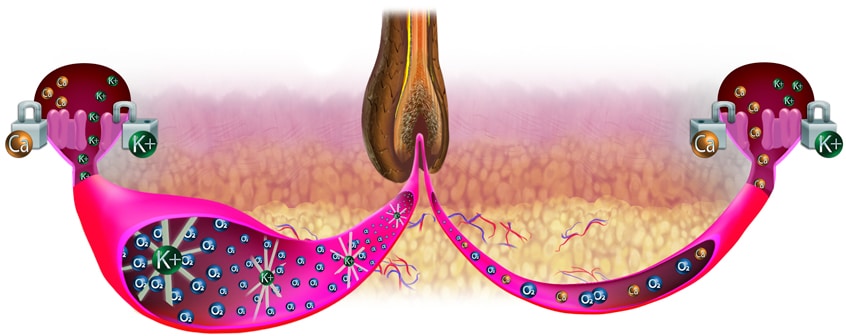 Side Effects: Facial hair growth was reported in 3-5% of women.
Side Effects: Facial hair growth was reported in 3-5% of women.
Regenerative Treatments
ECM ( Extra Cellular Matrix )
ECM is a type of Structural Scaffolding composed of various protein molecules such as laminin, collagen, and fibronectin, all woven together in a web-like geometry. ECM comes in powder form and mixed with normal saline. When it is injected into the scalp, it forms the structural scaffold and send the message to the bone marrow stem cells. Bone marrow stem cells move to the area of scaffold and scaffold act as a glue that holds the stem cell and get them to work and help regenerate the new blood vessel, collagen, fat cells, skin cells and these stem cells help the weaker hair cells to become stronger and restore the normal hair growth cycle.

PRP ( Platelet Rich Plasma )
This process involves taking your own blood and centrifuge to concentrate and isolate the platelets and plasma from other blood cells. The concentrated platelets are activated, and they release many growth factors. The most important ones for regenerating the hair are,
- Insulin like growth factors ( regulate cell growth )
- Vascular endothelial growth factors ( regenerate new blood vessels )
- Keratinocytes growth factors ( regenerate new skin cell )
- Platelet derived growth factors ( regenerate collagen )
- Basic fibroblast growth factors ( regulate cell growth and collagen )
Isolated plasma contains fibrinogen and its activated to fibrin by calcium chloride. Activated platelets and plasma are injected into the scalp just below the skin level. Fibrin provide the scaffold and act as a glue that holds the growth factors and provides the platform to get them to work and help regenerate the new blood vessel, collagen, skin cells and regulated the cell growth and help the weaker hair cells to become stronger and restore the normal hair growth cycle.
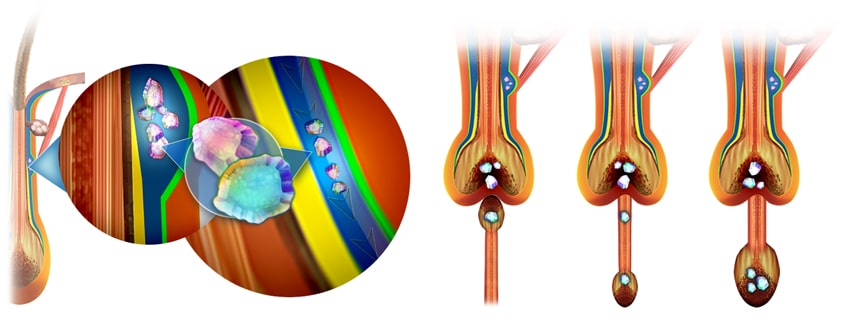
ECM and PRP can be injected into the scalp together and complement each other to help the weaker hair to become stronger.
LLLT ( Low Level Light Therapy )
The existence of nearly all life on Earth is fueled by light from the Sun. Sunlight spectrum ranges mainly from ultraviolet to visible and infrared light. The ultraviolet radiation in sunlight has both positive and negative health effects, as it is both a principal source of vitamin D3 and skin cancers.
Application of lower dose of near infrared light promote tissue regeneration and reduce inflammation and referred as low level light therapy LLLT. The LLLT is in the red or near infrared spectrum ( 600 mm to 1000 mm ). It is typical applied for a minute on alternate days.
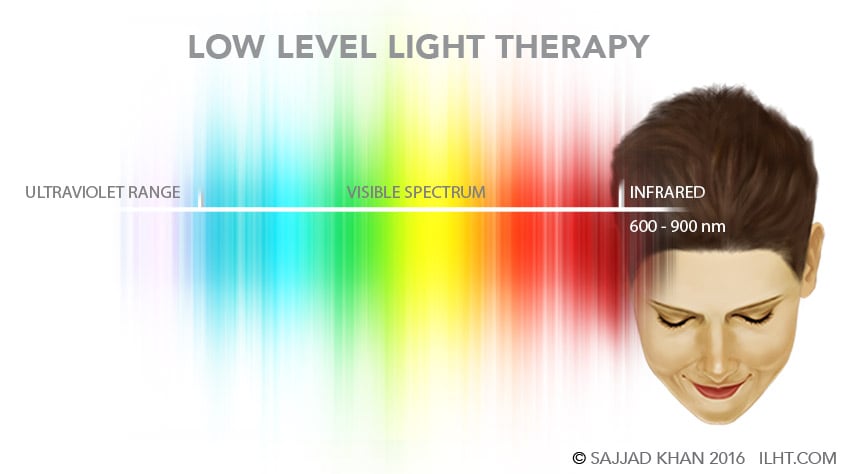
LLLT affect mitochondria and result in increase ATP energy generation and through the release of reactive oxygen species induce transcriptional changes in DNA results in increased cell longevity, neo-vascularization, collagen synthesis and promote healing.
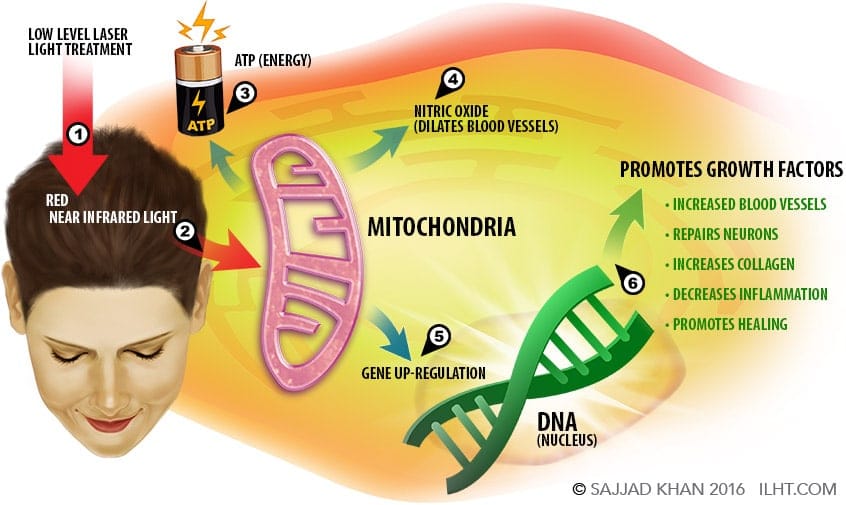
LLLT also enhance nitric oxide, it induces localized vasodilation and provides more nutrient to the cells. This process may reverse the hair thinning and restore the normal hair growth cycle.
Medicine Affecting The Male Hormone Pathways
Medicines for Other Diseases and Their Off-Label Use for Hair Loss:
Androgen Receptor Inhibitors
Spironolactone/Aldactone
Spironolactone (or its more popular brand name, Aldactone) is a member of a class of drugs called potassium-sparing diuretics (water pills). It is used to reduce the amount of fluid in your body without also causing a loss of potassium. It is also used to treat hypertension (high blood pressure) and edema (swelling). Spironolactone is an anti-androgen that works in two ways: it slows down the production of androgens in the adrenal glands and ovaries; it blocks the action of androgens, in part by preventing dihydrotestosterone DHT from binding to its andogenic receptor, which is one of the major cause of hair loss.
Cimetidine/Tagamet
Cimetidine (sold under the brand name Tagamet) belongs to a class of histamine blockers that are mainly used to treat gastro-intestinal ulcers. The histamine-blocking action prevents the stomach from producing excess acid, which in turn allows the body to heal the ulcer. Cimetidine also has a powerful anti-androgenic effect, and has been shown to block dihydrotestosterone from binding to the androgen receptor sites, which causes the hair loss.
Cimetidine has been used to treat hirsutism (excess facial hair growth) in women and has been studied as a potential treatment for women with androgenic alopecia. It has shown promising results.
8Cyproterone Acetate
Cyproterone Acetate is not FDA approved and is not available in the United States. Cyproterone acetate is used to reduce sex drive in men who suffer from excessive sex drive; it is also used for the treatment of pronounced sexual aggression. It is also prescribed to treat severe hirsutism in women of child-bearing age and female androgenic alopecia. Cyproterone acetate exerts its effects by blocking the binding of DHT (dihydrotestosterone) to its receptors. Because of its possible toxicity and potential long-term side effects, it is thought of as one of the last resorts for treating female-pattern hair loss.
Oral Contraceptives
Low-androgen-index birth-control pills decrease the production of ovarian androgens. They can also be used to treat women’s androgenic alopecia. smokers over the age of 35 who take ‘the pill” are at greater risk for blood clots.
Ketoconazole/Nizoral
Ketoconazole (sold under the brand name Nizoral) is currently used as an agent in the treatment of fungal infections. It also has antiandrogenic effects and can cause a reduction in the production of testosterone and other androgens by the adrenal gland and by the male and female reproductive organs (in women, the ovaries). Because of this action, it can be used to help treat hair loss.
Nizoral shampoo contains 2% ketoconazole and is prescribed not only for the treatment of scalp conditions but also, in combination with other treatments, for androgenic alopecia. A 1% version is now available over-the-counter, but it may not be as effective as the 2% prescription strength. There are no significant side effects.
Finasteride/Proscar/Propecia
The drug finasteride inhibits the enzyme 5-alpha reductase, thereby inhibiting the production of DHT. It works quite well in few women in both preventing hair loss and in triggering regrowth. Women must not take it if they are pregnant and must not get pregnant while on the drug: it can cause birth defects in a male child.
Cyproterone Acetate With Ethinyloestradiol/Diane 35/Diane 50
It’s not FDA approved and is not available in the United States. This compound is sold under the brand names Diane 35 and Diane 50. A contraceptive tablet, it is prescribed in Europe for women’s androgenic alopecia. The drug works by blocking some of the actions of those male hormones commonly present in women. Although it’s possible for the drug to stop further hair loss and trigger regrowth of hair within about a year, it must be used on an ongoing basis to maintain regrowth and eliminate hair loss. Possible side effects include breast tenderness, headaches, and decreased libido. It does have one positive side effect: it helps prevent osteoporosis. The drug is a combination of cyproterone and estradiol, an estrogen. Both Diane 35 and Diane 50 contain 2 mg of cyproterone. Diane 35 contains 0.035 mg of estradiol; Diane 50 contains 0.050 mg of estradiol. The drug is as effective, if not more so than spironolactone.
Surgical Treatments
Hair Transplant
Hair transplant is the only proven way to restore hair permanently onto the bald or thinning areas of the scalp. The procedure entails taking the hair from the back of the scalp, these hair are genetically different and are resistant to hair loss. The hair taken from the back of the scalp are relocated to thinning or bald area, where they will continue to grow for the permanently.
There are two standardized hair restoration techniques
- Follicular Unit Extractions referred as FUE, where single follicular units are punched out from the back of the scalp and relocated to thinning or bald area.
- Follicular Units Transplants referred as FUT, where hair bearing tissue is taken from the back of the scalp and individual follicular units are separated out of tissue under the microscopes and these follicular units are transplanted in the thinning or bald area.
The type of hair restoration surgery is chosen based upon the individual specific needs. Hair transplant procedures are performed under local anesthesia to minimize the pain during the procedure. Natural and permanent results of hair transplantation demand clinical expertise and as well as artistic creativity and ability on the part of surgeon.
Choosing The Right Surgical Technique
Presently there are two standardized techniques FUE, FUT.
FOLLICULAR UNIT EXTRACTION ( FUE )
Donor area is marked, a vertical line is drawn in front of the ear, behind this vertical line on the side and back of the scalp about 2cm of healthy hair are left in the upper and the lower margins. The area within the above mentioned margins is considered the Donor area for FUE.
Follicular unit extraction require the donor area be shaved. The donor area can be partially or completely shaved. If the Donor area is completely shaved, an average 2000-3000 follicular units can be extracted. If donor area is partially shaved in a way that top hair cover the shaved areas, in this situation an average 1000-1500 follicular units can be extracted. In women FUE is preferably performed by Partially shaving the donor area. Special micro punches are used to punch out the follicular units. Motorized micro punches are faster than manual.
Different Micro Punches For Fue
- Manual Micro Punches
- Motorized Micro Punches
- Motorized Suction Punches
- Robotic Micro Punch
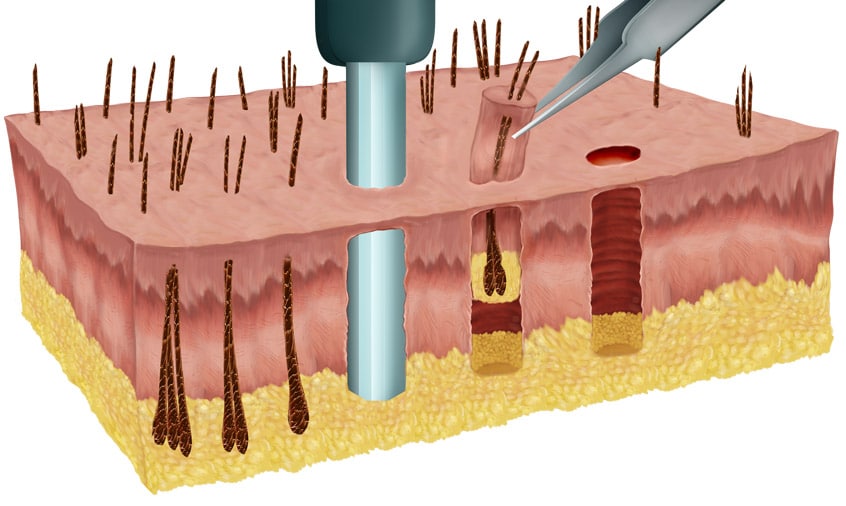
For follicular extraction doctors can choose any of the above punches depending on their preferences, the goal is to have minimum damage during FUE.
Advantages Of FUE
- Once the donor area heals, there is no noticeable scarring in the donor area.
- Client has the flexibility to wear the hair extremely short or even shave off the hair without the fear of any visible scaring in the donor area
Disadvantages Of FUE
- The micro punch is moved down over the follicular units to cut free the tissue around it, so the follicular unit is free to be extracted out with fine forceps. Due to not able to see clearly the hair direction in the scalp during this cutting process, there is an average 5% damage to the follicular units.
- The punching and extracting out process in FUE also can traumatize the follicular units, which can lead to poor hair survival.
- There is a limitation of an average 2000 to 3000 follicular units extraction in one surgery. Due to this limitation most of the time multiple hair transplants are required. The desired coverage is achieved in average two years time.
- If the donor area is shaved to extract maximum follicular units, extraction sites are visible for on an average 2 weeks time.
- In transplanted area, surgery is noticeable for an average 10-15 days.
- Due to noticeability of the tiny circular holes of follicular extraction sites in the donor area and transplanted look in the planted area, there is an average 10-15 days downtime to resume work.
- If the donor area is partially shaved in a way top hair cover the area, then surgery is only noticeable in the transplanted area.
- There is temporary numbness feeling in the Donor and transplanted area.
- Chances of shock hair loss in the transplanted area. Hair lost due to shock grows back along the transplanted hair.
Reasons To Choose FUE
If the life style of the client is to wear the hair very short like number 1 machine or keeping the hair shaved most of the time, FUE is better choice of not having any visible scarring in the donor area.
Follicular Unit Transplant / Long Hair Technique
A horizontal line is marked In the middle of the donor area, leaving an equal amount of hair above and below the line in the donor area. Depending on the individual flexibility and laxity of the scalp, this marked line is stretched on an average from 1cm to 2.5 cm. An incision of an average 0.5 mm deep in the direction of hair is made at the upper and lower borders of the marked donor area. Skin hooks are used to open up the upper and lower incision. The incision margins are stretched by skin hooks without any cutting, there is no damage to the hair. The extracted hairs in the tissue are intact and non-traumatized. Once the Donor tissue is out, there is an average 1-2 cm gap depending on the width of the extracted tissue and it has upper and lower skin margins. In any one of the skin margin, an average 1 mm wide and 3/4 mm deep superficial dermis is shaved, referred as Trichophytic Technique. In the tissue gap, ECM is laid for better healing. The upper and lower edges are fine stitched together. Hair grows out in the scar line because of Trichophytic technique and most of the time scar line becomes undetectable due to trichophytic closure.

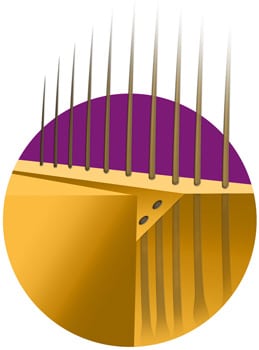

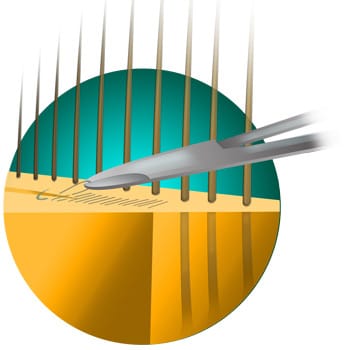
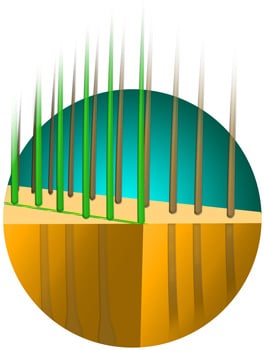
The follicular units are separated under the microscopes from the extracted tissue. The average hair damage in FUT during tissue removal and separating and preparing follicular units under the microscope is average from 0 to 0.4 % of the total number of hair.
Advantages of Long Hair Technique
- There is damages of 0 – 0.4% in comparison with FUE damage of 5% in follicular units preparation.
- FUT follicular units are intact and non-traumatized with almost 100% survival.
- An average 5000 follicular units can be performed in one surgery. If the flexibility and density are good, up to 8000 follicular units can be performed in one surgery. Due to higher chances of follicular shock in women, it’s preferable to limit the surgery to average 2000 follicular units.
- Higher follicular unit numbers and near100% survival help to achieve client’s goals in one surgery.
- The donor hair is not shaved or trimmed, stitches are covered by one’s own hair.
- Trichophytic technique, fine stitch closure and use of ECM, leads to very fine line scar or unnoticeable scar. The area is covered by one’s own hair.
- The same length transplanted hair on the front keep the surgery sites unnoticeable.
- The long hair transplanted in the hairline give the preview of the future hairline and outcome.
- Follicular units can be readjusted if needed during the surgery depending on the initial look.
- There is no surgical downtime, the individual could resume the work without any surgical noticeability.
Disadvantages of Long Hair Technique
- If a person trims the hair extremely short like No 1 Machine in the donor area or shaves off the hair, there are chances of noticeability of stitches mark or fine line scar in the donor area.
- Temporary numbness feeling in the donor area and transplanted area.
- Chances of shock hair loss in the transplanted area. Hair lost due to shock grows back along the transplanted hair.
Reasons To Choose The Long Hair Technique
- If the lifestyle is to wear the hair half an inch or more in length most of the time, long hair technique is the absolute best choice, especially in women.
- There is no surgical downtime, The individual can resume the work very next day.
- This technique also provides complete coverage in short amount of time than other techniques.



